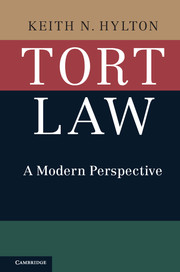Book contents
- Frontmatter
- Contents
- 1 Introduction
- 2 Policy and Tort Law
- 3 Evolution of Tort Law
- 4 Intentional Torts
- 5 Theoretical Foundations of Strict Liability
- 6 The Reasonable Person
- 7 Customs, Statutes, and the Reasonable Person
- 8 Inferring Negligence
- 9 Contributory Negligence and Assumption of Risk
- 10 Contributory Negligence, Comparative Negligence, and Incentives for Care
- 11 Joint and Several Liability, and Vicarious Liability
- 12 Factual Causation
- 13 Proximate Cause
- 14 Duty to Rescue and Special Relationships
- 15 Strict Liability: Conversion, Abnormally Dangerous Activities, and Nuisance
- 16 Defamation
- 17 Products Liability
- 18 Damages
- Index
11 - Joint and Several Liability, and Vicarious Liability
Published online by Cambridge University Press: 05 June 2016
- Frontmatter
- Contents
- 1 Introduction
- 2 Policy and Tort Law
- 3 Evolution of Tort Law
- 4 Intentional Torts
- 5 Theoretical Foundations of Strict Liability
- 6 The Reasonable Person
- 7 Customs, Statutes, and the Reasonable Person
- 8 Inferring Negligence
- 9 Contributory Negligence and Assumption of Risk
- 10 Contributory Negligence, Comparative Negligence, and Incentives for Care
- 11 Joint and Several Liability, and Vicarious Liability
- 12 Factual Causation
- 13 Proximate Cause
- 14 Duty to Rescue and Special Relationships
- 15 Strict Liability: Conversion, Abnormally Dangerous Activities, and Nuisance
- 16 Defamation
- 17 Products Liability
- 18 Damages
- Index
Summary
Joint and several liability governs the allocation of damages when there is more than one tortfeasor. Under joint and several liability, any one of the tortfeasors may be held liable for the entire damage award if the other tortfeasors are not parties in the lawsuit (say, because they have disappeared and cannot be found) or are unable to pay the judgment. Under several liability, tortfeasors are presumptively liable in equal shares, unless the court allocates the damages according to some other criterion such as relative fault. The inability to pay or the absence of some of the tortfeasors does not alter the court's allocation of responsibility for damages under several liability.
For example, suppose there are two tortfeasors, each equally responsible for the plaintiff's loss, and joint and several liability applies. If the plaintiff sues only one of the tortfeasors, that one tortfeasor may be held liable for the entire damages award. Alternatively, if the plaintiff sues both tortfeasors, and one of them does not have enough money to pay the damages award, the other can be held responsible for the entire award. Suppose, on the other hand, the several liability rule applies, and the plaintiff sues both tortfeasors (again, each equally responsible for the harm). Under several liability, each tortfeasor will be held liable for only 50 percent of the plaintiff's loss. If one of the tortfeasors cannot pay his share, the other tortfeasor's share of the damages (50 percent) remains the same.
Joint and several liability applies to cases involving conspiracy, concert of action, and concurrent tortfeasors. Conspiracy, familiar to students of criminal law, is an offense committed pursuant to an agreement among two or more actors, with intent to harm the plaintiff. If two offenders join to beat up the plaintiff, the court will apply the rule of joint and several liability in the plaintiff's battery lawsuit against the offenders.
Concert of action exists when two or more tortfeasors act according to a common plan or arrangement. The common plan could be an intentional tort, or it could be a course of conduct in which their negligence causes an injury to the plaintiff.
- Type
- Chapter
- Information
- Tort LawA Modern Perspective, pp. 180 - 194Publisher: Cambridge University PressPrint publication year: 2016



